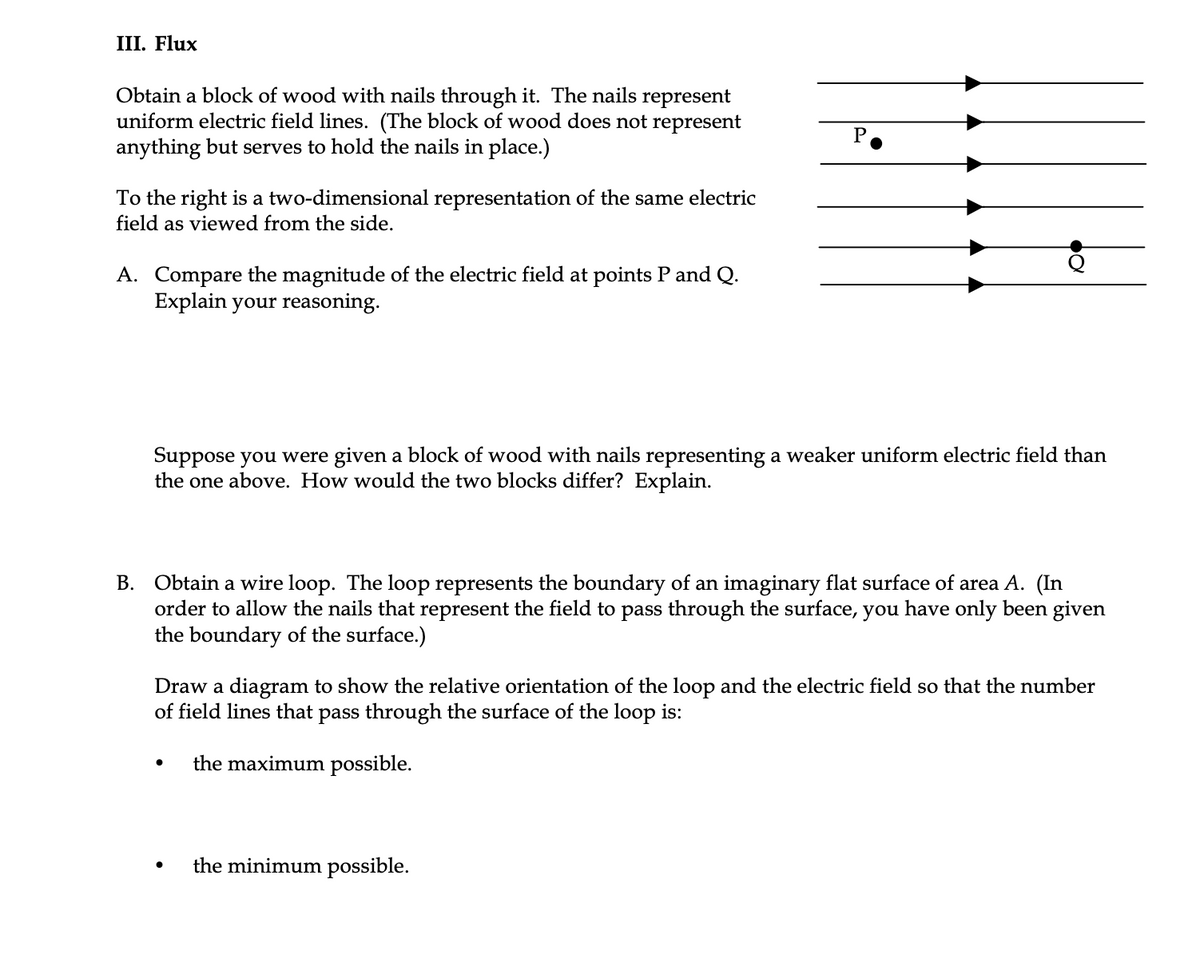Obtain a block of wood with nails through it. The nails represent uniform electric field lines. (The block of wood does not represent anything but serves to hold the nails in place.) P To the right is a two-dimensional representation of the same electric field as viewed from the side. A. Compare the magnitude of the electric field at points P and Q. Explain your reasoning. Suppose you were given a block of wood with nails representing a weaker uniform electric field than the one above. How would the two blocks differ? Explain. B. Obtain a wire loop. The loop represents the boundary of an imaginary flat surface of area A. (In order to allow the nails that represent the field to pass through the surface, you have only been given the boundary of the surface.) Draw a diagram to show the relative orientation of the loop and the electric field so that the number of field lines that pass through the surface of the loop is: the maximum possible.
Obtain a block of wood with nails through it. The nails represent uniform electric field lines. (The block of wood does not represent anything but serves to hold the nails in place.) P To the right is a two-dimensional representation of the same electric field as viewed from the side. A. Compare the magnitude of the electric field at points P and Q. Explain your reasoning. Suppose you were given a block of wood with nails representing a weaker uniform electric field than the one above. How would the two blocks differ? Explain. B. Obtain a wire loop. The loop represents the boundary of an imaginary flat surface of area A. (In order to allow the nails that represent the field to pass through the surface, you have only been given the boundary of the surface.) Draw a diagram to show the relative orientation of the loop and the electric field so that the number of field lines that pass through the surface of the loop is: the maximum possible.
Physics for Scientists and Engineers, Technology Update (No access codes included)
9th Edition
ISBN:9781305116399
Author:Raymond A. Serway, John W. Jewett
Publisher:Raymond A. Serway, John W. Jewett
Chapter24: Gauss’s Law
Section: Chapter Questions
Problem 24.2OQ: A coaxial cable consists of a long, straight filament surrounded by a long, coaxial, cylindrical...
Related questions
Question
Electricity and magnetic physics question

Transcribed Image Text:III. Flux
Obtain a block of wood with nails through it. The nails represent
uniform electric field lines. (The block of wood does not represent
anything but serves to hold the nails in place.)
P.
To the right is a two-dimensional representation of the same electric
field as viewed from the side.
A. Compare the magnitude of the electric field at points P and Q.
Explain your reasoning.
Suppose you were given a block of wood with nails representing a weaker uniform electric field than
the one above. How would the two blocks differ? Explain.
B. Obtain a wire loop. The loop represents the boundary of an imaginary flat surface of area A. (In
order to allow the nails that represent the field to pass through the surface, you have only been given
the boundary of the surface.)
Draw a diagram to show the relative orientation of the loop and the electric field so that the number
of field lines that pass through the surface of the loop is:
the maximum possible.
the minimum possible.
Expert Solution
This question has been solved!
Explore an expertly crafted, step-by-step solution for a thorough understanding of key concepts.
This is a popular solution!
Trending now
This is a popular solution!
Step by step
Solved in 2 steps with 1 images

Knowledge Booster
Learn more about
Need a deep-dive on the concept behind this application? Look no further. Learn more about this topic, physics and related others by exploring similar questions and additional content below.Recommended textbooks for you

Physics for Scientists and Engineers, Technology …
Physics
ISBN:
9781305116399
Author:
Raymond A. Serway, John W. Jewett
Publisher:
Cengage Learning

College Physics
Physics
ISBN:
9781285737027
Author:
Raymond A. Serway, Chris Vuille
Publisher:
Cengage Learning

College Physics
Physics
ISBN:
9781305952300
Author:
Raymond A. Serway, Chris Vuille
Publisher:
Cengage Learning

Physics for Scientists and Engineers, Technology …
Physics
ISBN:
9781305116399
Author:
Raymond A. Serway, John W. Jewett
Publisher:
Cengage Learning

College Physics
Physics
ISBN:
9781285737027
Author:
Raymond A. Serway, Chris Vuille
Publisher:
Cengage Learning

College Physics
Physics
ISBN:
9781305952300
Author:
Raymond A. Serway, Chris Vuille
Publisher:
Cengage Learning